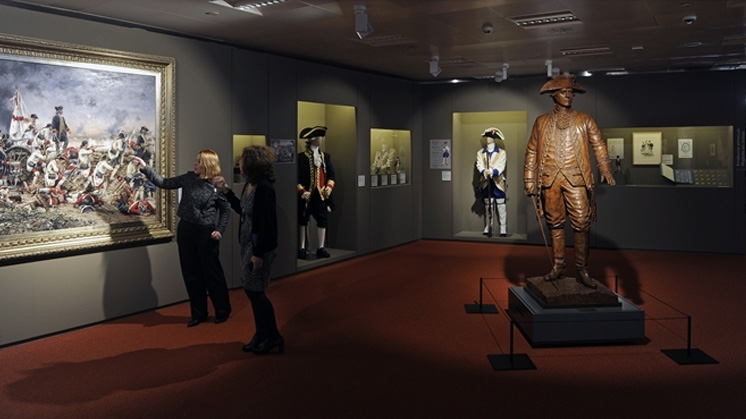Exposição em Bilbao: A Memória Recuperada
Descubra os vestígios da Espanha na história dos Estados Unidos
'A Memória Recuperada' reúne mais de 200 obras de arte, documentos e objetos que mostram a presença espanhola nos Estados Unidos, com especial atenção para a contribuição dos navegantes e comerciantes bascos.

"Eu soube por várias fontes de sua amizade com a América e da bondade que você demonstrou com muitos de meus compatriotas. Peço que aceite meu grato reconhecimento". Essas palavras de Benjamin Franklin, um dos fundadores dos Estados Unidos, ao militar de Bilbao Diego de Gardoqui recebem os visitantes da exposição e mostram o envolvimento da coroa espanhola no nascimento dessa nação, uma realidade histórica pouco conhecida.
Ao longo de cinco espaços complementares, o visitante faz um percurso desde o século XVIII, O Século das Luzes, até o século XX, A Luz de um século, quando a eletricidade mudou não só a vida das pessoas, mas também a própria sociedade.
DE 10 DE ABRIL DE 2017 A 02 DE JULHO DE 2017
BILBAO, TORRE IBERDROLA, 25.º ANDAR
HORÁRIOS:
DE TERÇA A SEXTA-FEIRA DAS 10H30 ÀS 14H30 E DAS 16H30 ÀS 19H30
SÁBADOS E DOMINGOS DAS 10H30 ÀS 14H30
ENTRADA:
GRATUITA COM RESERVA PRÉVIA. QUARTA-FEIRA ENTRADA LIVRE.
RESERVAS PELO NÚMERO 900 11 91 29
Durante a inauguração, Ignacio Galán, o presidente da Iberdrola, destacou que "ao organizar essa exposição, gostaríamos de contribuir com a recuperação das memórias que mostram a influência que os espanhóis — e os bascos, em particular — deixaram nos Estados Unidos ao longo de sua história, especialmente durante seu nascimento".
Camaradas de armas. Augusto Ferrer-Dalmau, 2016. Óleo sobre tela. Coleção particular Augusto Ferrer-Dalmau. Locução do vídeo (versão em espanhol) [PDF] Link externo, abra em uma nova aba.
Da Ilustração à indústria
A exposição parte do apogeu das ideias ilustradas e das ambiciosas reformas do reinado de Carlos III no século XVIII, quando a partir dos portos de Bilbao e Cádiz saíam barcos com dinheiro, armas, roupas, medicamentos e milhares de soldados para os Estados Unidos. O mar foi, ao mesmo tempo, via comercial e campo de batalha entre as forças navais da Inglaterra, França, Espanha e Holanda.
O século XIX foi marcado pela emigração de homens e mulheres — muitos deles do País Basco —, que deixaram vestígios em Nova York, do Spanish Aerocar que cruza as cataratas do Niágara aos rebanhos de ovelhas de Idaho ou aos frontões de Miami.
Com a chegada do século XX, a eletricidade se tornou parte imprescindível de nossas vidas. Em Bilbao, nasciam a Hidroeléctrica Ibérica e Saltos del Duero, origem da atual Iberdrola. Nos Estados Unidos, as empresas elétricas pioneiras surgiram na costa leste.
A exposição ocupa mais de 1.000 metros quadrados do 25.º andar da Torre Iberdrola, a sede da empresa em Bilbao.
A mulher no século XVIII
A sala Tertúlias, bailes e fogões destaca o papel da mulher no século XVIII, tanto na alta sociedade quanto nas classes mais baixas onde trabalhavam na venda de peixes e, inúmeras vezes, ficavam sozinhas e tinham que se encarregar das tarefas atribuídas naquela época apenas aos homens.
O curador da exposição, José Manuel Guerrero, destaca os casos de mulheres que se alistaram no exército para saírem da pobreza ou em busca de novos horizontes “muitas vezes se passando por homens, já que mulheres não podiam ingressar no exército”. Mar G. Lerma, da equipe de curadoria, cita também o protagonismo das mulheres de classe média e alta nos salões da época, onde se reuniam homens e mulheres para dançar, recitar, fazer encenações teatrais ou debater assuntos políticos.
As mulheres no século XVIII. Locução do vídeo (versão em espanhol) [PDF] Link externo, abra em uma nova aba.
Catálogo da exposição [PDF] Link externo, abra em uma nova aba. (*)
(*) Disponível na versão em espanhol.






